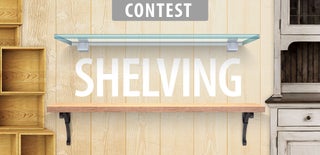Introduction: How to Build a Flush Mounted Shelf
I've never liked to see shelves where the top is not flush with the wall. It makes everything on the lean away from the wall.
Many years ago my dad was visiting and looking at our shelves, he asked how I mounted them so tight to the wall? He thought there would need to be screws thru the front of the shelf. Now you have to understand my dad was a mechanical engineer and always found ways to do things the cleanest way possible. Needless to say I was happy I stumped him. So this was a great compliment from him.
I'll show you how to make a shelf with a hidden mounting that keeps the shelf flush, secure and easily adjusted with no mounting hardware on the shelf.
I'll apologize to you now because you'll be looking at shelf mounting differently from now on.
Step 1: Materials Needed
Any type of wood will work, I chose black walnut because I like the dark, rich finish and more importantly I had some.
1 board 450mm x 150mm x 20mm (18" x 6" x 3/4")
2 pieces 100mm x 130mm x 20mm (5" x 6" x 2/4")
1 piece 350mm x 100mm x 15mm(14" x 4 1/4" x 1/2")
wood glue
sandpaper
pencil
Step 2: Shelf Brackets
- Sketch the brackets on one piece. Be careful to avoid any knots or other flaws in the wood.
- The brackets are 130mm x 110mm (4 1/2" x 5"). Make the shape about like I did, I used a spray paint can and a straight edge to make the curves and straight lines.
- Secure the 2 pieces together. I used drywall screws in the scrap part of the boards. You could use double sided tape, hot glue or anything else to hold them together.
- Cut both pieces on a band saw.
Step 3: Make the Shelf Back.
- Use the 100mm x 360mm x 12mm (4" x 14" x 1/2").
- Mark the center and mark 75mm (3") on each end (see pictures).
- Mark an arc on the center and 2 more to the end marks. I used a 5 gal bucket approx 300mm (12") dia.
- Draw a heart on the center. I used a washer to make smooth heart.
- Cut the curves and heart using a scroll saw or any other saw you have.
Step 4: Shelf Top.
- Cut top piece to 450mm x 150mm (18" x 6").
- Router a slot 5mm wide x 5mm deep (1/4" x 1/4") on the bottom of the shelf. Stop the slot 50mm (2") from each end.
- Optional: Cut a slot on the top using a 13mm (1/2") cove bit 80mm (3 1/4") from the back and on the top of the shelf. My wife likes this so she can put plates or pictures in the slot and lean them on the wall.
Step 5: Round Over All Exposed Edges and Sand.
- Round over all exposed edges using a 5mm (1/4") r router bit.
- Sand all parts to remove any burn marks left from the router.
- Sand all parts more using finer sandpaper.
- Sand all parts using finer sandpaper.
- Repeat steps 3 & 4.
- Dry assemble all parts and sand more if needed.
- If you planning on painting the shelf skip steps 3 thru 5.
Step 6: Glue It Together.
- I put a piece of plywood behind the back of the shelf to space it out from the wall to allow the screws in the wall used to hang the shelf to fit in the slot.
- Apply glue to the mating pieces then nail together. I used hidden dowels just because I don't like to try to hide the nail holes.
- If you're going to paint the shelf, don't worry about the nail holes.
Step 7: Apply a Finish.
I used spray shellac. Apply 2 or 3 coats then sand lightly using a very fine sandpaper, 400 grit or finer. Spray another coat after that.
Step 8: This Is What It Would Hang Like If I Used Metal Mounting Brackets.
I put some traditional mounting brackets on to show why I no longer use them.
With these brackets the top of the shelf is not tight against the wall, causing the shelf to tilt away from the wall. Things on the shelf will eventually fall off if the shelf vibrates or shakes even a little, like whenever someone closes a door.
Step 9: Hang the Shelf Up!
- Put 2 drywall screws level with each other, leave the heads out the thickness needed to fit into the slot on the shelf.
- Rest the shelf on the screws, adjust the screws in or out to get the shelf tight to the wall.
- You can slide the shelf side to side as needed.

Participated in the
Shelving Contest 2016













